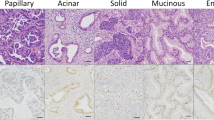Abstract
The aim of this study was to explore the expression and clinical significance of miR-494 and PTEN (phosphatase and tensin homologue deleted on chromosome ten) in non-small cell lung cancer (NSCLC). Immunohistochemistry for PTEN and in situ hybridization (ISH) for miR-494 were performed in 92 NSCLC tissues and 10 normal lung tissues to detect their expression, and correlation between their expression with clinical characteristics and prognosis was analyzed. The expression of miR-494 was significantly higher in NSCLC than in normal lung tissues (P = 0.004). The positive expression of PTEN protein in the lung carcinoma tissues was significantly lower than that in the normal lung tissues (P = 0.013), while the level of miR-494 expression was negatively correlated with PTEN expression (r = −0.577, P < 0.01). The high positive rate of miR-494 was positively correlated with pathological TNM (p-TNM) staging and lymph node metastasis. The expression of miR-494 was negatively correlated with grade of differentiation. However, the expression of PTEN was positively correlated with grade of differentiation. Patients with over-expression of miR-494 had a shorter overall survival (OS), while the negative group of PTEN was correlated with poor OS. MiR-494 over-expression and low PTEN expression are closely related to tumor p-TNM staging and lymph node metastasis, differentiation, and OS. Combined detection of PTEN and miR-494 can aid in determining malignancy degree and the prognosis of patients with NSCLC. MiR-494 may be served as a novel prognostic factor and may lead to new treatment strategies for NSCLC.



Similar content being viewed by others
References
Bartel DP. MicroRNAs: genomics, biogenesis, mechanism, and function. Cell. 2004;116:281–97.
Ambros V. The functions of animal microRNAs. Nature. 2004;431:350–5.
Zhao JJ, Yang J, Lin J, Yao N, Zhu Y, et al. Identification of miRNAs associated with tumorigenesis of retinoblastoma by miRNA microarray analysis. Childs Nerv Syst. 2009;25:13–20.
Liu L, Jiang Y, Zhang H, Greenlee AR, Han Z. Overexpressed miR-494 down-regulates PTEN gene expression in cells transformed by anti-benzo(a)pyrene-trans-7,8-dihydrodiol-9,10-epoxide. Life Sci. 2010;86:192–8.
Duan H, Jiang Y, Zhang H, Wu Y. MiR-320 and miR-494 affect cell cycles of primary murine bronchial epithelial cells exposed to benzo[a]pyrene. Toxicol In Vitro. 2010;24:928–35.
Romano G, Acunzo M, Garofalo M, Di Leva G, Cascione L, et al. MiR-494 is regulated by ERK1/2 and modulates TRAIL-induced apoptosis in non-small-cell lung cancer through BIM down-regulation. Proc Natl Acad Sci U S A. 2012;109:16570–5.
Kwak SY, Yang JS, Kim BY, Bae IH, Han YH. Ionizing radiation-inducible miR-494 promotes glioma cell invasion through EGFR stabilization by targeting p190B rhoGAP. Biochim Biophys Acta. 1843;2014:508–16.
Olaru AV, Ghiaur G, Yamanaka S, Luvsanjav D, An F, et al. MicroRNA down-regulated in human cholangiocarcinoma control cell cycle through multiple targets involved in the G1/S checkpoint. Hepatology. 2011;54:2089–98.
Kim WK, Park M, Kim YK, Tae YK, Yang HK, et al. MicroRNA-494 downregulates KIT and inhibits gastrointestinal stromal tumor cell proliferation. Clin Cancer Res. 2011;17:7584–94.
Duan H, Li X, Hu H, Li Y, Cai Z, et al. Functional elucidation of miR-494 in the tumorigenesis of nasopharyngeal carcinoma. Tumor Biol. 2015. doi:10.1007/s13277-015-3356-8.
Wang Y, Wang X, Zhang J, Sun G, Luo H, et al. MicroRNAs involved in the EGFR/PTEN/AKT pathway in gliomas. J Neurooncol. 2012;106:217–24.
Ettl T, Baader K, Stiegler C, Muller M, Agaimy A, et al. Loss of PTEN is associated with elevated EGFR and HER2 expression and worse prognosis in salivary gland cancer. Br J Cancer. 2012;106:719–26.
Gallardo A, Lerma E, Escuin D, Tibau A, Munoz J, et al. Increased signalling of EGFR and IGF1R, and deregulation of PTEN/PI3K/Akt pathway are related with trastuzumab resistance in HER2 breast carcinomas. Br J Cancer. 2012;106:1367–73.
Ji Y, Zheng M, Ye S, Chen J, Chen Y. PTEN and Ki67 expression is associated with clinicopathologic features of non-small cell lung cancer. J Biomed Res. 2014;28:462–7.
Travis WDCTCB. World Health Organization Inter-national histological classification of tumors; histological typing of lung and pleural tumors. Berlin: Springer; 1999.
Morse MA, Clay TM, Lyerly HK. Current status of adoptive immunotherapy of malignancies. Expert Opin Biol Ther. 2002;2:237–47.
Zhang Q, Wu Z, Zhang G. Expression of miR-145 in breast carcinoma and its significance. J Clin Exp Pathol. 2009;25(1):9–12.
Li G, Huang Y, He Y, Chen J, Yang K, et al. Study of miRNA signatures as biomarkers for early stage nonsmoking female lung cancer of xuanwei county of yunnan province. Cancer Research on Prevention and Treatment. 2012;39:802–6.
Liu Y, Lai L, Chen Q, Song Y, Xu S, et al. MicroRNA-494 is required for the accumulation and functions of tumor-expanded myeloid-derived suppressor cells via targeting of PTEN. J Immunol. 2012;188:5500–10.
Sun HB, Chen X, Ji H, Wu T, Lu HW, et al. MiR494 is an independent prognostic factor and promotes cell migration and invasion in colorectal cancer by directly targeting PTEN. Int J Oncol. 2014;45:2486–94.
Meng F, Henson R, Wehbe-Janek H, Ghoshal K, Jacob ST, et al. MicroRNA-21 regulates expression of the PTEN tumor suppressor gene in human hepatocellular cancer. Gastroenterology. 2007;133:647–58.
Leslie NR, Foti M. Non-genomic loss of PTEN function in cancer: not in my genes. Trends Pharmacol Sci. 2011;32:131–40.
Zhang JG, Wang JJ, Zhao F, Liu Q, Jiang K, et al. MicroRNA-21 (miR-21) represses tumor suppressor PTEN and promotes growth and invasion in non-small cell lung cancer (NSCLC). Clin Chim Acta. 2010;411:846–52.
Conflicts of interest
None
Author information
Authors and Affiliations
Corresponding author
Additional information
Juan Wang and Huitao Zhang contributed equally to this work.
Rights and permissions
About this article
Cite this article
Wang, J., Chen, H., Liao, Y. et al. Expression and clinical evidence of miR-494 and PTEN in non-small cell lung cancer. Tumor Biol. 36, 6965–6972 (2015). https://doi.org/10.1007/s13277-015-3416-0
Received:
Accepted:
Published:
Issue Date:
DOI: https://doi.org/10.1007/s13277-015-3416-0




